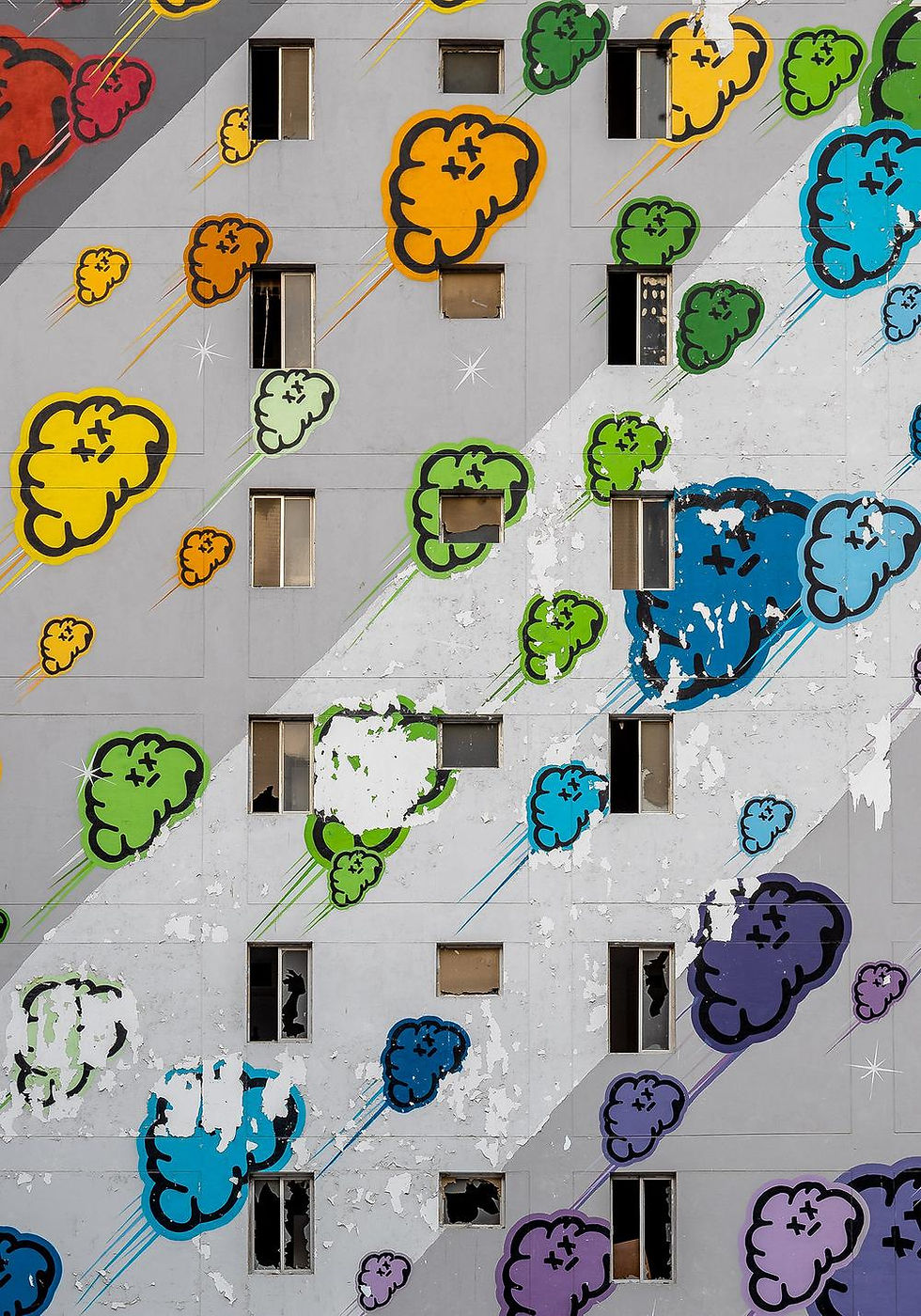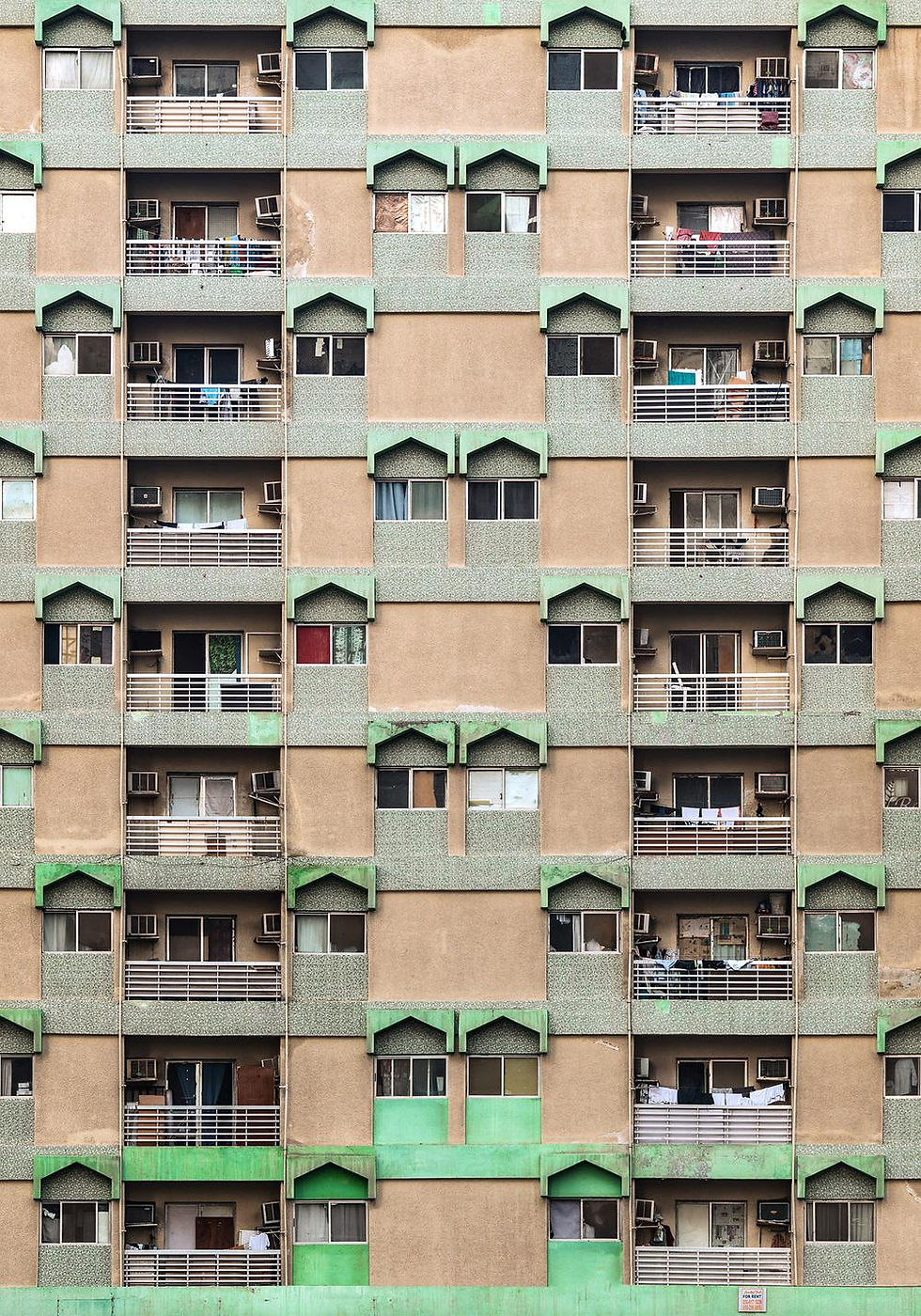Symmetry and Memory, Hussain Al Moosawi
- BAYT AL FANN
- Jan 24, 2022
- 6 min read
The UAE has famously undergone extraordinary shifts during the past few decades to exist at the forefront of modernity. In an attempt to preserve the ever-changing nature of this landscape, Emirati photographer and graphic designer Hussain Al-Moosawi has dedicated his future to capturing architecture – both appreciated and overlooked – by means of his iconic graphic style.

We talk to Hussain about his connection to photography, rediscovering the UAE’S urban landscapes and the power of storytelling and memory making through pictures.
When did you first own a camera and what is your earliest memory of photography?
My earliest memory was around the age of 14, during a school trip to Hatta in Dubai. I had a family camera which I used to take photos of the trip. When I received the photos back from being developed, they had not come out well. I remembered this always, as although the images didn’t look right, they had a unique beauty to them. Those memories of the trip and school at that time has stuck with me.

I was trained to use a Pentax film camera in college in 2001 and here I appreciated what photography was. My first recollection of a camera I bought with my own money was a digital camera in 2005. Going digital meant more control over what I photograph and I saved up for a digital SLR. At this moment I was able to experiment and document my social environment, until I was able to decide what to do with this medium.

With over 15 years of experience in the realms of design, photography, and visual journalism, what has been the most challenging moment of your journey as a creative?
The most challenging has definitely been limiting myself to a specific area of expertise. For example, as a graphic designer I was taught to become a master of branding and advertising. And that’s what initially I limited myself to and focused on.
After studying graphic design at college, I decided that branding wasn’t the career path for me. So, I moved onto a different journey as a hybrid - a content creator and designer. At the time, this was a really hard decision to make and was really challenging. I have come to peace with my creative practice now. It took some time to make this decision, but I feel I am in the right space. I am now much more flexible and open to ideas and possibilities as a consequence. My practice has grown, and I am able to work as a storyteller for brands, as opposed to focusing on branding in the traditional taught context.

You have been on a quest to rediscover the UAE’s urban landscapes, through systematically documenting its overlooked modern architecture. What inspired you to document building facades in the UAE?
I am a person who is usually not driven by inspiration, but rather issues. This is possibly the journalist in me, always looking for an issue to document and present to the world. The issue I was driven by to create this body of work was the fact I could not make sense of my surroundings anymore. In design school they teach you everything is designed, nothing is random. Decisions are made from street signings to the position of roads, and I consciously look at places and spaces and consider the design and why decisions were made.

In the mid to late 2000s the UAE experienced a real estate boom. I was living in Australia at the time, and when I would return home, I would encounter new clusters of buildings, which didn’t resonate or connect with me. When I moved back to the UAE in 2013, I was trying to make sense of a span of forty years in a nutshell. I was looking back at the basic structures that were built at the time when the nation was created, as I feel that was our heritage and identity until architecture was influenced by international elements. In 2017, whilst in Australia I realized symmetry could help me make sense of spaces and started looking at buildings through a symmetrical lens. Now I am very much interested in not just city planning but also country planning. I take pictures to makes sense of the place. I usually take huge volume of pictures. The number will depend on the specific subject of a space as I feel that gives me the ownership and knowledge to understand the place. This underlines my methodology from start to finish.

What interests you about the relationship between people, places and spaces?
Many of us are interested in how buildings look from the outside and that’s how we connect with them. I am always interested in the duality, buildings with a public perspective. If you live in a building, how do people and families experience it. I am interested in the exterior and interior; and how psychologically our feelings change when we enter and leave buildings. In the future, I might perhaps couple the picture with the people who once lived with them and capture the emotions of the humans who connected with the buildings.

How do you choose a facade for your project? How do you create the compositions of your photography?
Firstly, some of these buildings have already been considered as heritage, secondly, I use my intuition and make a decision based on whether I think the architecture has historical value. I also consider what details of the building connect to our Arab and Islamic heritage.
By our heritage I mean not only Emirati identity, but also wider Middle Eastern Islamic cultural heritage. I am not formally trained as an architect, but I have an eye to detect the historical significance of a building, I am then able to research later the background to the building.
It could be for example aspects of architecture that was created to make the building cool and habitable for the climate. Or it could be a building that has details that connect to privacy, which resonates with how I was raised, and my value for privacy for people who live in a place. Those techniques happened to borrow from classic Islamic architecture examples.

What has been the response from old and young residents of the UAE to your project. Have they shared any interesting stories around these buildings?
Mostly people from Abu Dhabi have found many connections to my work. This is perhaps because the city centre has changed so much, especially in terms of demographics. The works have created a sense of nostalgia, which people connected to. However, that was not my aim, but the emotional element cannot be ignored. Even if people did not live in the buildings, they feel a connection to the memories of the building generally. For example, H.E Noor Al Kabbi, The Minister of Culture and Youth, noticed a particular building had a special connection to her as it had been Abu Dhabi’s first Baskin and Robbins, which she frequented often as a child. Those kinds of memories stay with us always and I enjoy hearing people’s stories about how the architecture in my photographs was a part of their life.

From your perspective, how strong is the storytelling power of photography?
Storytelling manages to capture something that you don’t see, and when that is coupled with an image it is extremely powerful. A good story always starts with thoughts in our heads, considered alongside an image it adds tremendous meaning. This is something I think of when I am working on exhibitions and bodies of work.
What advice would you give to creatives who aspire to become photographers?
Don’t think about photography, think about the subject matter and great pictures will just happen. Now, there is so much focus on the medium, we rarely see amazing pictures. Think about how you would approach the image if you didn’t have a camera, how would you draw the scene or write about the scene for example, it will help you to identify what you want to communicate. Then when you have a camera you will know exactly what you should be doing and what you are looking for.

What does the future of Islamic art look like to you?
I think it is very exciting as Islamic art is seen as something traditional, however it can be flipped around to something futuristic which people do not anticipate. Islamic art is definitely not antiquated and something from the past. I believe people who live in the Islamic world will really help shape and own the narrative away from an orientalist gaze.
Islamic art is something which can’t be specifically defined. There may be an element of it that relates to Islamic ideals and traditions and cultures. It is overall human art, that includes elements that makes it Islamic art. I believe there are lots of possibilities as long as we don’t confine ourselves to a definition. It’s a fluid process but us owning the narrative is a huge factor to developing it for the future.

For more information check out https://hugraphic.ae/
The views of the artists, authors and writers who contribute to Bayt Al Fann do not necessarily reflect the views and opinions of Bayt Al Fann, its owners, employees and affiliates.









I appreciate you sharing such thoughtful content. it’s an absolute must-read ! Real Pune Service {} Chennai Service {} High-Prole Chennai Service {} Trusted Hinjewadi Service {] Independent Wakad Service {} Real Baner Service {} Hotel Escorts In Pune {} Pimple Saudagar Service {} Bavdhan Service {} Kothrud Service {} Magarpatta Service {} Lonavala 410401 (+) Ravet 410121 (+) Wakad 411057 (+) Hinjewadi 411057 (+) Baner 411045 (+) Aundh 411007 (+) Pimple Saudagar 411021 (+) Shivaji Nagar 411027 (+) Kalyani Nagar 411014 (+) Viman Nagar 411014 (+) Magarpatta City 411013 (+) Pimpri Chinchwad 411033
Best IPTV Unlock stunning 4K quality with a wide range of live TV channels and on-demand content for an unbeatable viewing experience.. Best IPTV
代发外链 提权重点击找我;
google留痕 google留痕;
Fortune Tiger Fortune Tiger;
Fortune Tiger Fortune Tiger;
Fortune Tiger Slots Fortune…
站群/ 站群;
万事达U卡办理 万事达U卡办理;
VISA银联U卡办理 VISA银联U卡办理;
U卡办理 U卡办理;
万事达U卡办理 万事达U卡办理;
VISA银联U卡办理 VISA银联U卡办理;
U卡办理 U卡办理;
온라인 슬롯 온라인 슬롯;
온라인카지노 온라인카지노;
바카라사이트 바카라사이트;
EPS Machine EPS Machine;
EPS Machine EPS Machine;
EPS Machine EPS Machine;
google seo…
03topgame 03topgame;
gamesimes gamesimes;
Fortune Tiger…
Fortune Tiger…
Fortune Tiger…
EPS Machine…
EPS Machine…
seo seo;
betwin betwin;
777 777;
slots slots;
Fortune Tiger…
seo优化 SEO优化;
bet bet;
무료카지노 무료카지노;
무료카지노 무료카지노;
google 优化 seo技术+jingcheng-seo.com+秒收录;
Fortune Tiger Fortune Tiger;
Fortune Tiger Fortune Tiger;
Fortune Tiger Slots Fortune…
站群/ 站群
gamesimes gamesimes;
03topgame 03topgame
EPS Machine EPS Cutting…
EPS Machine EPS and…
EPP Machine EPP Shape…
Fortune Tiger Fortune Tiger;
EPS Machine EPS and…
betwin betwin;
777 777;
slots slots;
Fortune Tiger Fortune Tiger;